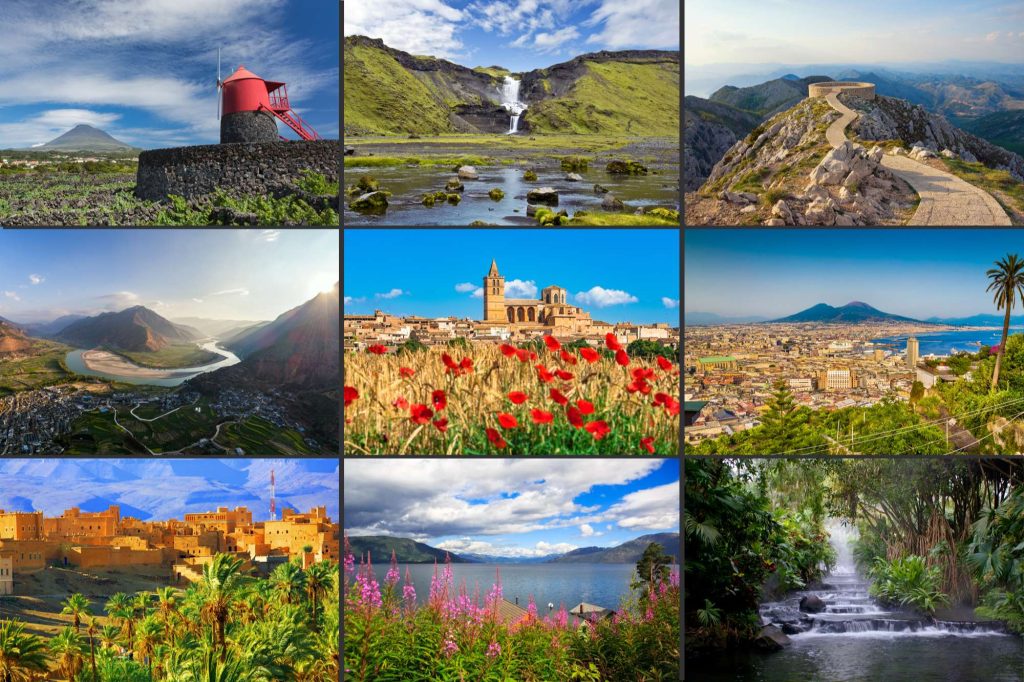Destination Guides
These handy guides give you a quick introduction to the destination your child is visiting, including average temperatures, currency and language spoken.
You can visit the main destination pages for more information on why we fell in love with these countries and your school’s teacher or trip leader will be able to provide more information on the trip specifics.

The Azores
The Azores are nine Portuguese Islands, which can be found in the middle of the Atlantic Ocean, making them Europe’s westernmost point. The Azores were created at the junction of three tectonic plates, making the islands an inspirational destination for geographers. The largest of the nine Islands is Sao Miguel.
| Language spoken: | Portuguese |
| Currency: | Euros |
| Population: | 245,766 people |
| Average highest temperature: | 25°C in August |
| Average Lowest Temperature: | 12°C in January |
| Spending money: | The cost of living in the Azores is low in comparison to the UK and many European destinations.
Bottle of water: €0.50 The cost of lunch at a local restaurant: €10 Toy rooster, Portugal’s vividly coloured Barcelos “good luck” rooster, popular in the Azores: €4 on average. |
Costa Rica
Located in Central America, Costa Rica boarders Nicaragua, Panama, the Caribbean Sea and the Pacific Ocean. Costa Rica is the poster child for ecotourism, it contains 5% of the world’s biodiversity and produces 99% of its energy from renewable sources. Costa Rica is a democratic and peaceful country and it has not had an army since 1948.
| Language spoken: | Spanish |
| Currency: | Colon |
| Population: | 4.99 million people |
| Average highest temperature: | 27°C in July and August |
| Average Lowest Temperature: | 14°C in January |
| Spending money: | 1 pound is approximately 733 Costa Rican Colon.
Water bottle: 785.20 ₡ An empanada from a street food vendor: 900 ₡ Pura Vida T shirt: 11,500 ₡ |
Iceland
Iceland is an island located where the North Atlantic and Artic Oceans meet. Iceland was created by divergence at the Mid Atlantic Ridge. It is a land full of volcanoes, glaciers, waterfalls, jagged coastlines and other incredible geographical features unmatched by any other place on Earth.
| Language spoken: | Icelandic |
| Currency: | Icelandic Krona |
| Population: | 357,000 people |
| Average highest temperature: | 13°C in July and August |
| Average Lowest Temperature: | -3°C in January |
| Spending money: | £1 is approximately 177 ISK.
Prices for sandwiches and drinks are comparable to those in many coffee shop chains in the UK and the mid-range super markets comparable to high end supermarkets in the UK. The delicious Icelandic confectionary, Lindu Rís Buff, costs on average 600 ISK. |
Italy
Italy is a Mediterranean country located in Southern Europe. On the south-western coast you find the Bay of Naples in the Campania region and Rome, the capital of Italy, situated in the Lazio region. Off the south west coast, you’ll find Sicily, the largest island in the Mediterranean and home to Europe’s largest volcano, Mount Etna.
Sicily:
| Language spoken: | Italian |
| Currency: | Euros |
| Population: | 5 million people |
| Average highest temperature: | 26°C in July and August |
| Average Lowest Temperature: | 5°C in January and February |
| Spending money: | €4 for a slice of Pizza
€5-10 for a key ring or small souvenir €2 for a small gelato |
Bay of Naples:
| Language spoken: | Italian |
| Currency: | Euros |
| Population: | 3.1 million people |
| Average highest temperature: | 32°C in July |
| Average Lowest Temperature: | 3°C in January and February |
| Spending money: | €7.50 for a whole margarita pizza
€20 for good quality t-shirt €2 for a small gelato |
Rome:
| Language spoken: | Italian |
| Currency: | Euros |
| Population: | 2.8 million people |
| Average highest temperature: | 32°C in July |
| Average Lowest Temperature: | 3°C in January and February |
| Spending money: | €7.50 for a whole margarita pizza
€5-10 for a key ring or small souvenir €2 for a small gelato |
Montenegro
Montenegro is located in the South of Europe, on the coast of the Balkans. Fringed by the Adriatic Sea, Montenegro also shares its boarders with 5 states: Croatia, Bosnia and Herzegovina, Kosovo, Albania and Serbia. The country is just 100 kilometres from head to toe, but is bursting with geography and adventure for all students.
| Language spoken: | Montenegrin |
| Currency: | Euros |
| Population: | 622,359 |
| Average highest temperature: | 32°C in July and August |
| Average Lowest Temperature: | 1°C in January |
| Spending money: | €1.50 for a pizza slice
€0.30 for a postcard €2.50 for a cappuccino |
Norway
Situated in Northern Europe, Norway is one of the four countries that make up Scandinavia. The majority of Norway borders water including the Norwegian Sea, North Sea and Barents Sea. Famed for Fjords, mountains and northern lights, Norway has exceptional geography and a national passion for the great outdoors, no matter the weather. Norway is also a shining example of a sustainable country. In addition to educating their pupils from a young age about the importance of being green, Norway has many eco-friendly achievements. One of the biggest is that Norway recycles 97% of their plastic bottles.
| Language spoken: | Norwegian |
| Currency: | Norwegian krone |
| Population: | 5.368 million |
| Average highest temperature: | 18°C in July and August |
| Average Lowest Temperature: | -1°C in February |
| Spending money: | £1 is approximately 10 NOK.
24 NOK for a bottle of water 180 NOK for an average meal in a local restaurant 35 NOK for a sharing bar of Norwegian chocolate |